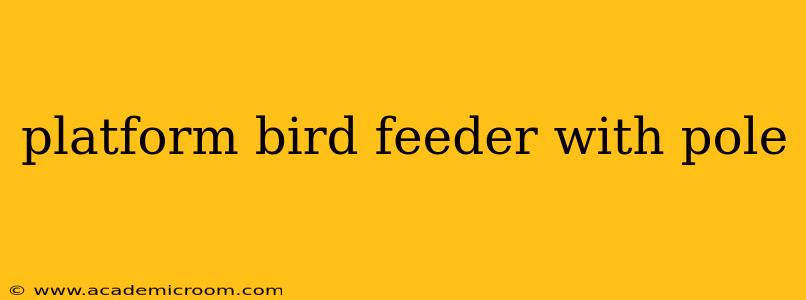Choosing the right bird feeder can significantly impact the variety and number of feathered friends visiting your backyard. Platform feeders, particularly those mounted on poles, offer a unique advantage, providing accessibility for a wide range of bird species. This comprehensive guide will explore the benefits, considerations, and best practices for using platform bird feeders with poles.
What are the Advantages of a Platform Bird Feeder with a Pole?
Platform feeders offer a broad, flat surface where birds can comfortably feed. Unlike tube feeders that cater to specific beak sizes, platform feeders are accessible to a broader range of birds, including those with shorter, stouter beaks like doves, juncos, and sparrows. Mounting the feeder on a pole elevates it, offering several crucial advantages:
- Predator Protection: Raising the feeder above the ground reduces the risk of predation from cats, raccoons, and other ground-dwelling animals. This allows smaller, more vulnerable birds a safer feeding opportunity.
- Improved Visibility: A pole-mounted feeder offers better visibility for both you and the birds. You can easily observe your feathered visitors, and the birds can spot the feeder from a distance.
- Easier Cleaning: A pole-mounted feeder is easier to reach and clean, ensuring hygiene and preventing the spread of diseases among birds.
- Versatile Placement: Poles allow for flexible placement; you can position the feeder near trees or shrubs for added cover and protection.
What Types of Birds are Attracted to Platform Feeders?
Platform feeders are known to attract a diverse range of bird species, including:
- Doves: Mourning doves and other dove species are frequent visitors to platform feeders.
- Juncos: Dark-eyed juncos are ground-feeding birds that readily utilize platform feeders.
- Sparrows: House sparrows, chipping sparrows, and other sparrow species often frequent these feeders.
- Blackbirds: Grackles and starlings will visit platform feeders, though some birders may wish to deter these species.
- Larger birds: Some larger species like robins, towhees, and even smaller quail might also use a platform feeder, especially if other food sources are scarce.
How High Should I Mount My Platform Bird Feeder?
The ideal height for your pole-mounted platform feeder depends on several factors, including the surrounding environment and the types of predators in your area. Generally, a height of 4-6 feet is a good starting point. This height offers sufficient protection from ground predators while still allowing for easy access for smaller birds. If you have persistent predator issues (e.g., large cats), you might consider mounting the feeder higher. Remember to consider the height and reach of the pole when cleaning and refilling the feeder.
What Should I Consider When Choosing a Platform Bird Feeder with a Pole?
Selecting the right platform feeder involves considering several crucial factors:
- Size: Choose a size appropriate for the number of birds you expect to attract. Too small a platform can lead to competition and aggression.
- Material: Look for durable, weather-resistant materials like metal or treated wood. Avoid materials that might leach harmful chemicals into the bird food.
- Weight Capacity: Ensure the feeder's weight capacity can support a full feeder and multiple birds simultaneously.
- Ease of Cleaning: A feeder that's easy to disassemble and clean will help prevent the spread of disease.
- Pole Type: Choose a sturdy pole made from durable material like metal or pressure-treated wood, ensuring it's properly secured in the ground.
What Kind of Food is Best for a Platform Feeder?
Platform feeders can accommodate a variety of bird foods, including:
- Seeds: Sunflower seeds (black oil sunflower seeds are a favorite), cracked corn, millet, and nyjer seeds are all excellent choices.
- Suet: Suet cakes or blocks provide high-energy nutrition, especially beneficial during colder months.
- Fruit: Sliced apples, oranges, or berries can attract a different range of birds.
How Do I Protect My Platform Bird Feeder from Squirrels?
Squirrels are notorious for raiding bird feeders. Several strategies can help deter squirrels:
- Squirrel Baffle: Install a squirrel baffle on the pole below the feeder to prevent squirrels from climbing up.
- Weight-Activated Feeders: Some feeders are designed to close when a heavier animal like a squirrel lands on them.
- Location: Position the feeder away from trees or other structures that squirrels might use to reach it.
By carefully selecting the right platform bird feeder with a pole and implementing appropriate deterrent strategies, you can create a thriving bird habitat in your backyard and enjoy the delightful spectacle of various bird species feeding comfortably and safely.
